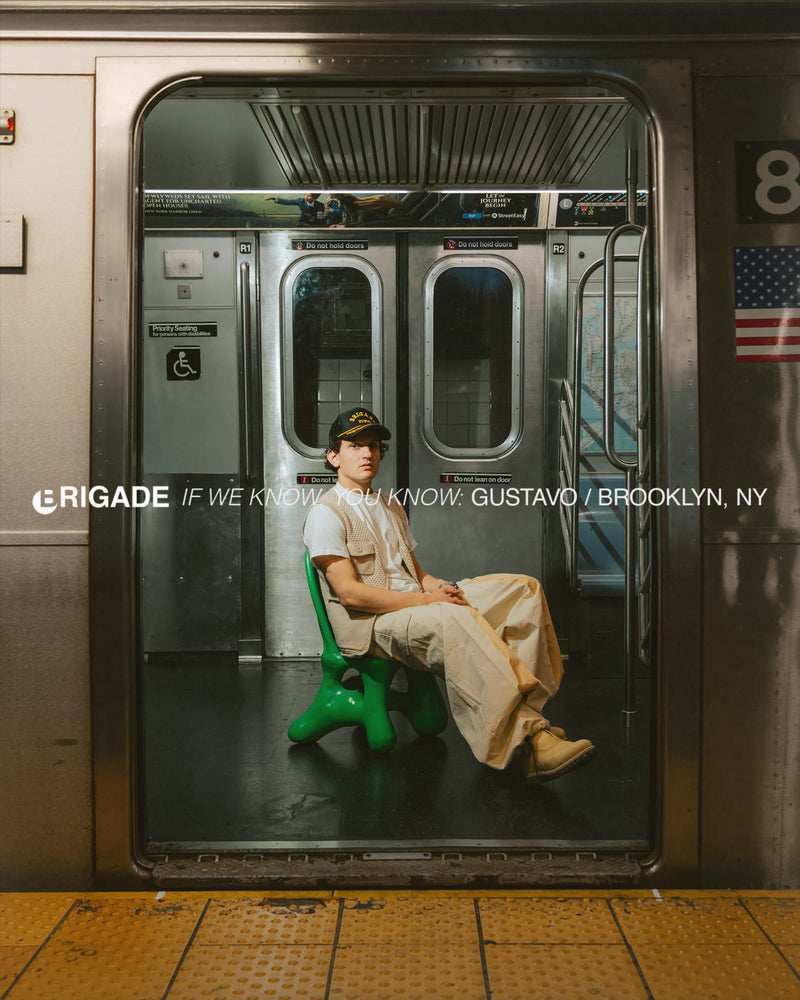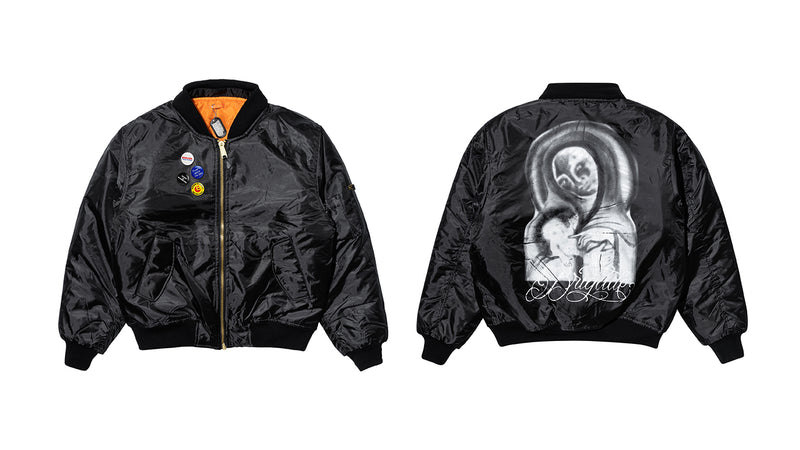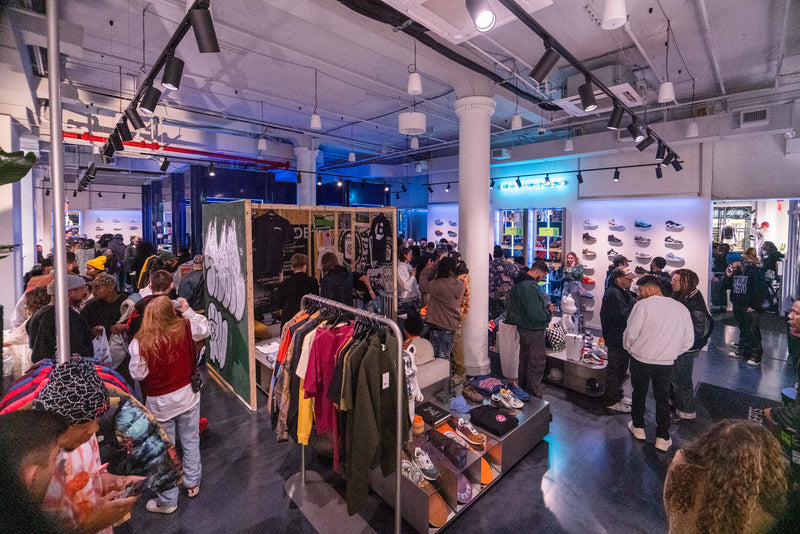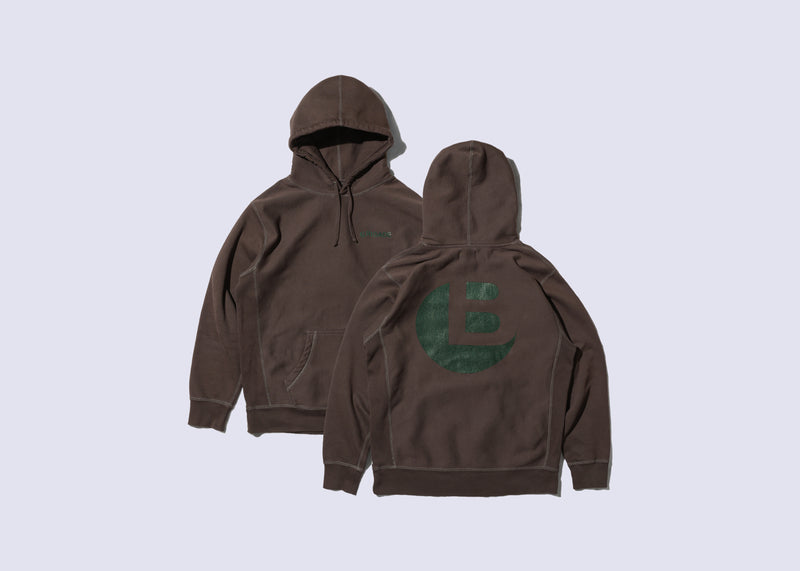
“Holy shit, I feel like I can do this…”
In 2019, we crossed digital paths with Gustavo Barroso through our mutual friend Samm McAlear. Perhaps from a “real recognize real” viewpoint, we followed each other without ever interacting. He was enrolled at the Massachusetts College of Art and Design, and we were in NYC. He had his first ever show May 10th, 2019 on Canal Street and extended us an invitation. Even though we had only seen each other through social media, Gustavo announced our arrival immediately as if we were family that traveled in for the show. Since then, we’ve become close friends, supporting each other in our endeavors. Whether we have an intricate manufacturing project where we need insightful eyes or if he needs still life imagery of his artwork, we have a support system on which we can mutually rely.

Gustavo’s journey encapsulates the pursuit of the American dream, and what is made possible with hard work, perseverance and resourcefulness. While Gustavo was born in a small agricultural town within São Paulo, Brazil, at the age of four his parents immigrated to New Hampshire. Both of his parents took laborious jobs within factories to provide for the family, laying a foundation for Gustavo’s future pursuits. It wasn’t until high school that Gustavo discovered his passion for art, particularly through graphic design, which eventually led to his exploration into industrial design. With his parent’s unwavering emotional support, Gustavo’s trajectory was altered upon attending the Massachusetts College of Art and Design, where his eyes were opened to the possibilities within the art world, a realm that once seemed inaccessible.

Embracing his journey at the Massachusetts College of Art and Design, Gustavo found himself challenged and motivated by his peers and professors, propelling him to carve out his own path. His journey took a significant turn when he met KidSuper on Instagram and took a bus to New York to help the brand in 2017. This experience introduced him to individuals at the same age who made a livelihood through their artistic endeavors, which fueled Gustavo’s realization that his dream of owning his own art studio was within reach.
At this point in time, Gustavo is independently funding and running his own art studio and has several art shows under his belt nationwide. While this in itself is enough for most to stop and take pause, Gustavo is looking towards an ambitious 10 year plan of owning a self-sustaining farm/workshop in both Brazil and New York, intertwining his passion for art, circular design, and community.

• How did you find design?
I discovered design through graphic t-shirts. I was lucky because in my school there was a graphic design and printing program, which I became the president of. In the morning, I would silk screen my own t-shirts, and then I would carry them around the hallways and sell them for like $10. From graphic design I learned about fashion, and I ultimately became interested in architecture, fashion design, graphic design, but I didn't really feel like committing to one. Then I learned about industrial design, and I learned that industrial designers are the people, essentially, that design everything. They'll design a shoe, a doorknob, furniture. They're designing all of these products all around us. I wanted to study industrial design because I felt like it was a place where I would learn a lot of different skills, and I would be able to create a lot of different ideas.

• What was your path like from New Hampshire to New York?
I left Nashua, New Hampshire, to go to Boston and study industrial design at the Massachusetts College of Art and Design.
My whole life changed once I went down to Boston. I was the art kid at my high school, but once I got to college, I was never in a class where I was the best at anything. It was good because I was just surrounded by people that were all way better than me skills wise. It just pushed me to work really hard because I felt like I needed to work harder than everybody to be even close to as good. If you're the most “successful person” or “wisest” in the room, and everyone thinks that you're the shit, I feel like that doesn't really help you grow. Whereas if you're surrounded by people that are much better than you at certain things, you can learn and grow from them. That’s why I like to be around other people that are better than me at certain things.

I studied industrial design there for four years, which was incredible because you had access to so many resources. You had the metal shop, the wood shop, and 3D printers, and being in college was the first time I ever had access to anything like this. It was the first time I was ever able to even think in 3D. Before that, everything was just in my notebook.
While in college I also went to a museum for the first time, and it was trippy because I was around kids whose parents were professional artists, who grew up being exposed to the art world, people that had museum memberships and were exposed to multiple different artists.
Then there was me, and my first time I ever stepped foot inside of an art museum was the MFA in Boston, and I was 19 years old.

My parents were just trying to survive, and they weren't interested in leisure activities such as art and culture. They were very supportive of me, but they weren't college educated. Going to museums is very much a leisure that I feel like mostly the middle and upper class partakes in.
• What was your first museum experience like?
Honestly, the first time I ever went into a museum, especially the contemporary museum, I was like, "Holy shit, I feel like I can do this."
It's funny to me because a lot of people hate on contemporary art because of, you know, sometimes it seems unskilled, and a lot of people get mad by it.
I got inspired, more than inspired, it motivated me. I was like, "Wow, if these people are in a museum, I can do it too."
Being in college, was the first time, through my professors, that I was around people that made a living from art and design. Until that point, I didn't know anyone who made a living from art and design. When in school, I used to take the bus to New York to help KidSuper, that was the first time that I had ever been around kids my age (20) that were making a living from art and design.
And then it really felt like, "Holy shit, you guys are doing it, I can do it too."

• What was one of the first pieces you created and what is your favorite piece you've created?
The first chair I ever made was the green slime chair and it's probably my most known piece. It was the first thing I made after college and I had no tools or money so I made it from cardboard and paper bags I found in the trash.
My favorite piece is always the next one just because when I make something, I'm excited about it, and then I share it with the world and move on. Especially with how fast sharing things with the internet is nowadays. After putting together a show, you see the show, it's really exciting but then it's like okay, well, what am I going to do next week?
The first thing I do after having a big show or having any big moment is take out the trash, clean my room, just do things that keep me grounded.

• What is the ideal environment for you to create in?
I mean, the ideal environment is just somewhere where I can just get really messy, honestly. Messy, dusty, dirty, you know, all that. Also, somewhere where I can control the sound.
I like working in silence. No music. Sometimes I'll listen to music, but if I need to be thinking about anything, I like silence.
Ideally, I need to be able to go from silence to really loud music sporadically. I'm like, "Yo, we need silence." Then after 30 minutes of silence, I'm like, "Yo, let's put on 50 Cent," and then we blast it. Then after like four songs, I'm like, "All right, back to silence."

• What do you consider your biggest accomplishment to date?
I really do feel like my biggest accomplishment is just continuing to keep the studio running completely self-funded.
I have people who are paying attention to my work that I've never met before in my life. I have strangers all around the world who somehow or someway have come across my work and it resonates with them for whatever reason. I think that within itself is an accomplishment.
I think there's a lot of really talented artists out there who never get that opportunity to show their work.
I am grateful for the opportunity, and I think that's an accomplishment within itself for sure.

• Describe your dream project.
So my dream lifelong project is to build a self-sustaining farm, or two, one in Brazil in rural Sao Paulo, and one in a place like rural New York.
I want to produce all of our own energy and grow our own food and just have the biggest shop ever with a bunch of robots. There will also be mad livestock – cows, chickens.
I think being able to be self-sustaining and having independence is a driving factor. I think like right now I'm so disconnected from all of my food and my energy. Like if there's a power outage, I'm useless. Even if I just can't use the internet, I'm like 10% of a human. I don't even know where my food comes from, and that kind of scares me because what if one day the food just stops coming. I want a greenhouse in my house, and I want to build a giant geodome and have my house inside of it. This idea really values art and design, but circular design specifically which is something I haven’t even really tapped into yet. Circular design takes a lot of resources. For those who are not familiar, circular design is essentially thinking about the entire lifecycle of a product, not only the manufacturing process, but the raw materials all the way through the afterlife of the product. I want to build the most high-tech, high-efficiency farm/studio you've ever seen.

Within the same idea, I want to create an artist community, and possibly an artist in residency program on the farm. I really want there to be ways that we can invite talented, underprivileged youth to come and develop their skills. I want to create a space for kids, like me, who never had access to a shop before but can draw really well, to come and make anything they want because we have a metal shop, a wood shop, 3D printers, and robots.
Within the farm we will also have a massive sculpture park. The whole endeavor is going to be like a performance piece. It's also in a way like conceptual art, because for the farm to operate, there's going to need to be certain instructions and certain things that can be passed on to other people, and ideally it lives on way longer than I do. I want it to be something that a lot of other people get to experience. That's the goal.

Even with the aforementioned journey Gustavo has been on in his life in mind, he mentions:
“I find it so tone deaf when creative people talk about working hard. 'Success' is a lot about the boat that you're in and not how hard you're rowing…
There are millions of people in this city that work extremely difficult and thankless jobs just to make ends meet and they have zero upward mobility. They don't have a way for them to increase their luck, you know? So, when I hear creative people boasting about how hard they work, it irks me because spending a lot of time on your craft is the bare minimum. And even after we spend a lot of time on our craft we aren’t entitled to any sort of recognition or 'success.'"

Gustavo’s art is constantly evolving, using cultural icons as a visual language tool that allows him to communicate ideas, and enter a conversation that was started long before him. His story and commentary is just beginning, and we are looking forward to days spent on one of his circular farms in the near future.




0 comments